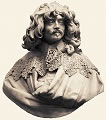|
|
 |
Costume
Quotes: Gentlemen
|
 |
France
1644 Les Loix de la Galanterie
No one is more changeable than the French: sometimes their hats
mount high, sometimes sink low, sometimes their basques are large,
sometimes small, their breeches long or short: as to collars, out
fathers wore small simple ones, while we began with circles of cardboard
over which we laid a starched collar, after that we had a kind of
unstarched cape which reached almost to the elbow, and then after
that collars became smaller and of a reasonable size, though at
the same time there were large tubular-pleated ruffs with enough
linen in them to make sails of a windmill: now these are all discarded
and our collars are so small that they are like sleeve cuffs. Wide
bucket-tops are now only seen on heavy boots, the lighter boots
worn today have dropped down to the spurs, and have only a peak
in front and behind. As to the canons displayed above the boots
- we like them very large and of fine starched lawn although they
then resemble paper lanterns. And we like them even more ornate,
of two or three layers of fine lawn or linen, and better still if
they are trimmed with two or three rows of point de Gènes which should be the same as for the jabot. You know that
ribbons and points are called la petite oye, and the opening
of the shirt in front is called the jabot, and it must always be
trimmed with lace, for it is only an old fogey who buttons his doublet
all the way down. Let's go back to the boots: they must always be
long in the foot even if that is extravagant and against nature.
When high boots came into fashion, hats were worn with such high
pointed crowns that a coin could cover the top, but that has suddenly
changed and now they are low and round, but the long boots remain
which shows how popular they are. Then the spurs - they must be
of heavy silver, and you must keep changing their design without
heeding the cost. Those who wear silk stockings should always have
English ones, and the garters and the shoe rosettes should be as
fashion dictates. There are certain small etceteras which cost little
but show elegance (galanterie), as for example: placing in
the hat a beautiful ribbon, gold or silver, sometimes mixed with
coloured silk; and in front of the breeches seven or eight beautiful
satin ribbons of the most brilliant colours possible. You might
say that this display of trimmings turns your person into a shop
exhibiting its wares, however, this is what is worn and this fashion
of ribbon trimmings adds very much to the elegance of a man, and
that is why they are called galants.

France
1662 Journal Dangeau
Once and for all I should explain what is a juste-au-corps à
brevet. When the king (Louis XIV) was first in love with Mme.
de la Valliere and no longer kept it secret, the Court was at Saint-Germain,
and Versailles was still the small hunting-lodge built for Louis
XIII. The king with a few friends used to go there once or twice
a week to spend part of the day with Mme. de la Valliere, so he
designed a blue coat, lined with red, and with a red waistcoat,
both embroidered with a special design; he gave a dozen of them
to those friends he allowed to accompany him on these little private
visits to Versailles; only those who had such coats could go with
him without first asking permission. Afterwards the number of these
coats was extended to forty, but never exceeded that number; when
one became vacant, the king granted the favour of wearing it by
a brevet issued by the State Secretary of the King's Household,
and from that it was called a juste-au-corps à brevet.
They gave no special privileges or entries; their only distinction
was that they could be worn during times of mourning and were allowed
when gold and silver trimming on coats was prohibited.

England
1663 The Life and Times of Anthony Wood
A strange and effeminate age when men strive to imitate women in
their apparell, viz. long periwigs, patches in their faces, painting,
short wide breeches like petticoats, muffs, and their clothes highly
scented, bedecked with ribbons of all colours.

England
1660-1666 Diary Samuel Pepys
1660. May 24. Up, and made myself as fine as I could, with
the linning stockings on and wide canons that I bought the other
day at Hague.
1661. April 6. Among other things met with Mr. Townsend,
who told me of his mistake the other day, to put both his legs through
one of his knees of his breeches, and went so all day.
1662. June 12. I tried on my riding-cloth suit with close
knees, the first that I ever had; and I think they will be very
convenient, if not too hot to wear any other open knees after them.
1663. May 9. At Mr. Jervas's, my old barber, I did try two
or three borders and periwigs, meaning to wear one; and yet I have
no stomach, but that the pains of keeping my hair clean is so great.
May 10. (Lord's day). Put on a black cloth suit with white
lynings under all, as the fashion is to wear, to appear under the
breeches.
Oct. 30. At my periwig-maker's, and there showed my wife
the periwig made for me.
Nov. 2. I heard the Duke say that he was going to wear a
periwig; and they say the King also will. I never till this day
observed that the King is mighty gray.
Nov. 3. Home, and by and by comes Chapman, the periwig-maker,
and upon my liking it, without more ado I went up, and there he
cut off my hair, which went a little to my heart at present to part
with it; but, it being over, and my periwig on, I paid him 3 pounds
for it; and away went he, with my own hair, to make up another of
it.
Nov. 8. (Lord's day). To church, where I found that my coming
in a periwg did not prove so strange as I was afraid it would, for
I thought that all the church would presently have cast their eyes
all upon me, but I found no such thing.
1666. Oct. 8. The King hath yesterday in Council declared
his resolution of setting a fashion for clothes, which he will never
alter. It will be a vest, I know not well how; but it is to each
the nobility thrift, and will do good.
Oct. 13. To White Hall, and there the Duke of York was just
come in from hunting. So I stood and saw him dress himself, and
try on his vest, which is the King's new fashion, and he will be
in it for good and all on Monday next, and the whole Court: it is
a fashion, the King says, he will never change.
Oct. 15. This day the King begins to put on his vest, and
I did see several persons of the house of Lords and Commons too,
great courtiers, who are in it; being a long cassocke close to the
body, of black cloth, and pinked with white silk under it, and a
coat over it, and the legs ruffled with black riband like a pigeon's
leg: and, upon the whole, I wish the King may keep it, for it is
a very fine and handsome garment.
Oct. 17. The Court is all full of vests, only my Lord St.
Albans not pinked, but plain black; and they say the King says the
pinking upon whites makes them look too much like magpies, and,
therefore, hath bespoke one of plain velvet.
Nov. 4. (Lord's day). My taylor's man brings my vest home,
and coat to wear with it, and belt and silver-hilted sword; so I
rose and dressed myself, and I like myself mightily in it, and so
do my wife... and so, it being very cold, to White Hall, and was
mighty fearful of an ague, my vest being new and thin, and the coat
cut not to meet before, upon my vest.

England
1666 Diary John Evelyn
Oct. 18. To court. It being the first time his majesty put
himself solemnly into the Eastern fashion of vest, changeing doublet,
stiff collar, bands and cloake, into a comely vest, after the persion
mode, with girdle or straps, and shoe strings and garters into bouckles,
of which some were set with precious stones, resolving never to
alter it, and to leave the French mode, which had hitherto obtain'd
to our greate expence and reproch. Upon which divers courtiers and
gentlemen gave his majesty gold by way of wager that he would not
persist in his resolution. I had sometime before presented an invective
against that unconstancy, and our so much affecting the French fashion,
to his majesty, in which I tooke occasion to describe the comliness
and usefulness of the Persian clothing, in the very same manner
his majesty now clad himselfe. This pamphlet I intitl'd Tyrannus,
or the Mode, and gave it to his Majesty to reade. I do not impute
to this discourse the change which soon happen'd, but it was an
identity that I could not but take notice of.

France
1692 Journal Dangeau. Marriage of M. de Chartres
and Mdlle. de Blois
Monsieur was in black velvet embroidered all over in gold and trimmed
with rubies. The king had a coat of gold brocade embroidered with
silver, and a strap of very large diamonds as a shoulder-knot, instead
of the ribbon loops usually worn there. Monseigneur was in plain
black velvet which enhanced the brilliance of the large diamonds
which decorated it; they belonged to the Crown and were worth several
millions.

France
1697 Journal Dangeau. Celebrations for the Marriage
of Monseigneur le Duc du Bourgogne and Mme. la Princesse de Savoie.
On Wednesday, in the gallery at Versailles, there was the most magnificent
ball that had ever been given at Court. Words fail to describe the
richness and diversity of the clothes, they were so unimaginably
brilliant that they dazzled the eyes. Monseigneur was in a cloth
of gold, decorated with silver. The duc de Bourgogne was in black
velvet, and the duc d'Anjou and the duc du Berry in coloured velvets,
all three embroidered all over in gold and diamonds. Monsieur had
the same suit as on the day of the wedding, it was superb, of black
velvet with very wide gold embroidered froggings set close together,
and large diamond buttons; his waistcoat was of gold and the rest
of his apparel of the same splendour. M. de Chartres was very rich
and elegant in cloth of gold trimmed with gold. Some of the courtiers
had velvet suits, either embroidered or with ornamental froggings,
others were in gold brocade. There were a few plain coats but most
of them were embroidered, or had gold or silver lace. They all had
very ornate shoulder-knots, the sleeves covered with gold and silver
lace and ribbons, gloves also trimmed with ribbons, silk stockings
of different colours with gold clocks, and ribbons in their shoes.

England
1714 The Spectator
August 16. The skirt of your fashionable coats forms as large
a circumference as our petticoats; as these are set out with whalebone,
so are those with wire, to encrease and sustain the bunch of folds
that hangs down on each side, and the hat, I perceive is decreased
in just proportion to our head-dresses.

England
First half of 18th century A Foreign View of England in
the Reigns of George I and George II. César de
Saussure
I daresay it would interest you to hear of the style and the way
Englishmen usually dress. They do not trouble themselves about dress,
but leave that to their womenfolk. When the people see a well-dressed
person in the streets, especially if he is wearing a braided coat,
a plume in his hat, or his hair tied in a bow, he will, without
a doubt, be called a 'French dog' twenty times perhaps before he
reaches his destination. Englishmen are usually very plainly dressed,
they scarcely ever wear gold on their clothes; they wear little
coats called 'frocks', without facings and without pleats, with
a short cape above. Almost all wear small round wigs, plain hats,
and carry canes in their hands, but no swords. Their cloth and linen
are of the best and finest. You will see rich merchants and gentlemen
thus dressed and sometimes even noblemen of high rank, especially
in the morning, walking through the filthy and muddy streets. The
lower classes are usually well dressd, wearing good cloth and linen.
Englishmen, however, are very lavish in other ways. They have splendid
equipages and costly apparel when required. Peers and other persons
of rank are richly dressed and when they go to Court, especially
on gala days, when their grand coaches, with their magnificent accoutrements
are used... The Quaker's mode of dressing is as curious as is their
language; the men wear large, unlooped, flapping hats, without buttons
or loops; their coats are as plain as possible, with no pleatings
or trimmings, and no buttons or button-holes on the sleeves, pockets,
or waists. If any brother were to wear ruffles to his shirt or powder
in his hair, he would be considered impious. The most austere and
zealous do not even wear shoebuckles, but tie their shoes with cords...
Quakers' clothes, though of the simplest and plainest cut, are of
excellent quality; their hats, clothes, and linen are of the finest.

Female
Costumes
Ladies' Baroque Clothing
Indoor
Garments | Footwear | Accessories | Hairstyles | Head-dresses | Development
of the Fontange
Hairstyles
by Vermeer | Dress
Colours by Vermeer | Head-dresses
by Vermeer
Costume Focus Headwear & Neckwear | Costume
Focus Working Women
Costume
Focus Children's Clothing
Ladies'
Costume Quotes
Male
Costumes
Gentlemen's Baroque
Clothing
Indoor Garments | Footwear | Accessories | Hairstyles | Head-dresses
Costume
Colours by Vermeer | Hair-
and Head-dresses by Vermeer
Gentlemen's Costume Quotes
~ ~ ~ ~ ~ ~ ~ ~ ~ ~ ~ ~ ~
Embroidery Gallery | Gallery of Needlework
Engravings
Lace Gallery &
Identification | Glossary
Contents © N. Kipar 1997 |









